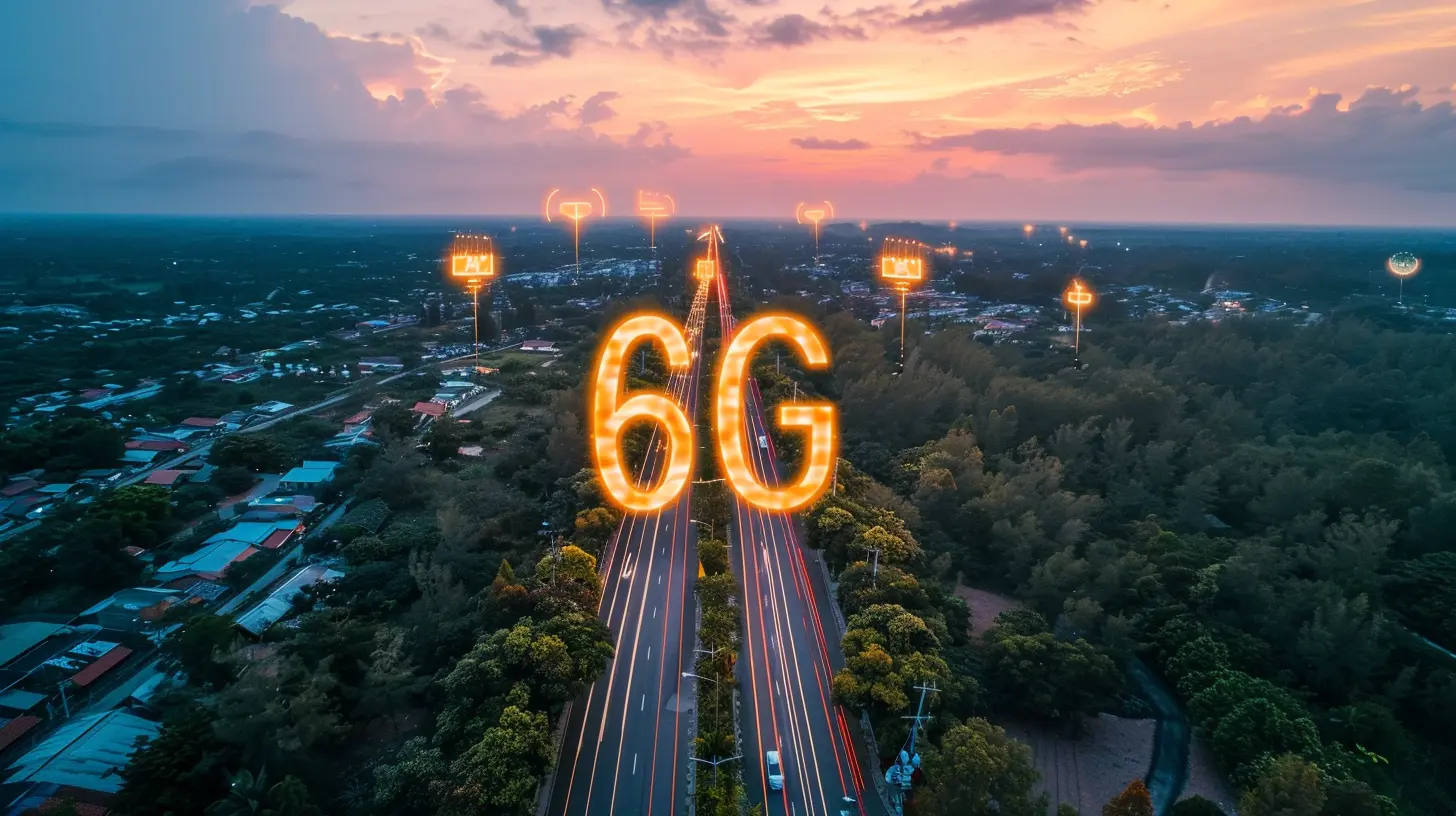The Rise of 6G: What to Expect from the Next Generation of Wireless
27 June 2025
The world is still adapting to the incredible power of 5G, but tech visionaries are already setting their sights on something even bigger—6G. The next generation of wireless technology promises to revolutionize how we connect, communicate, and interact with the digital world. But what does this mean for us? How will 6G change our daily lives and industries?
Let’s dive into the future of wireless connectivity and see what we can expect from 6G technology. 
What is 6G?
6G, or the sixth-generation wireless technology, is the anticipated successor to 5G. While we're still in the early stages of development, experts predict that 6G will be faster, more efficient, and even more transformative than its predecessor. It’s expected to provide ultra-fast speeds, almost zero latency, and seamless connectivity across all devices.The goal? To create a world where digital and physical realities blend effortlessly, paving the way for advancements like real-time holographic communication, fully autonomous systems, and AI-driven smart cities. Sounds like something out of a sci-fi movie, right? 
How Fast Will 6G Be?
If you think 5G is fast, wait until you hear about 6G. While 5G offers speeds up to 10 Gbps, 6G could reach a mind-blowing 1 terabit per second (Tbps). That’s 100 times faster than 5G!To put it into perspective, downloading a full HD movie with 5G takes around 10 seconds. With 6G, it could happen in the blink of an eye—literally within a fraction of a second. This speed won’t just make streaming or gaming better; it will open doors to entirely new possibilities, like instant cloud computing and immersive virtual experiences. 
Key Features of 6G
So, what makes 6G so special? Let’s take a closer look at the technological advancements that will define the next generation of wireless.1. Mind-Blowing Speed & Bandwidth
As mentioned earlier, 6G will be incredibly fast. But that’s not all. It will also offer significantly higher bandwidth, allowing multiple devices to connect without any slowdowns. Whether it’s a smart home, an entire city, or a futuristic workspace, every device will communicate seamlessly in real-time.2. Ultra-Low Latency
Latency is the delay between sending and receiving data. With 5G, latency is around 1 millisecond, but 6G aims to reduce this even further—to mere microseconds. This will enable real-time applications like remote surgeries, drone delivery services, and fully autonomous vehicles to operate without a hitch.3. AI-Powered Connectivity
6G won’t just be about speed; artificial intelligence (AI) will play a major role in optimizing networks. AI-driven algorithms will help manage traffic, predict network demands, and enhance overall efficiency, making connections smarter and more reliable.4. Holographic Communication
Remember those 3D holograms in sci-fi movies? They might become a reality with 6G. Real-time holographic calls could replace traditional video conferencing, creating a more immersive and interactive communication experience. Imagine attending a work meeting as a hologram instead of just watching it on a screen!5. Integration with the Human Body
Sounds futuristic, right? Researchers believe that 6G could introduce brain-computer interfaces, allowing humans to interact with devices using just their thoughts. This could revolutionize healthcare, gaming, and even daily interactions with technology.6. Sustainable & Energy-Efficient Networks
Sustainability is a major concern in tech development, and 6G aims to tackle that head-on. The next-gen network will focus on energy efficiency, using AI to optimize power consumption and reduce environmental impact.
How Will 6G Impact Industries?
The rise of 6G won’t just mean faster internet for our smartphones—it will reshape industries in ways we can only begin to imagine.1. Healthcare
6G will take telemedicine to new heights. Remote surgeries will become safer and more precise, thanks to ultra-low latency. Wearable health devices will provide real-time diagnostics, potentially preventing serious health issues before they arise.2. Autonomous Vehicles
Self-driving cars rely on real-time data processing. With 6G, communication between vehicles, traffic signals, and city infrastructure will be instantaneous, making roads safer and reducing traffic congestion.3. Smart Cities
Picture a city where every building, streetlight, and vehicle is connected. 6G could power smarter cities with automated traffic control, energy-efficient buildings, and AI-driven infrastructure management.4. Augmented & Virtual Reality (AR/VR)
The leap from 5G to 6G will make AR and VR fully immersive, with no lags or delays. This could revolutionize everything from gaming to education, enabling real-time virtual classrooms and interactive learning experiences.5. Space Communication
With discussions about colonizing Mars and privatized space travel heating up, 6G could play a crucial role in seamless space communication. It may even support future interplanetary internet networks (yes, that’s a thing being discussed!).When Can We Expect 6G?
While 6G is still in its early research phase, experts predict that it could be commercially available by 2030. Major tech companies and governments worldwide are already investing billions into 6G research to ensure they stay ahead of the curve.However, widespread adoption will take a few extra years, just like we’ve seen with 5G. Upgrading infrastructure, developing compatible devices, and ensuring global implementation all take time. But when it arrives, it’s set to be revolutionary.
Challenges of 6G Development
As exciting as 6G sounds, it’s not without challenges.1. Infrastructure Overhaul
Deploying 6G will require a complete revamp of existing wireless infrastructure. New towers, satellites, and fiber-optic networks will need to be developed.2. Higher Energy Consumption
While 6G aims to be energy-efficient, handling massive data transfers at ultra-high speeds could still pose power challenges. Innovations in sustainable energy will be critical.3. Cybersecurity Risks
With faster, more connected devices comes a risk—cybersecurity threats. Ensuring that 6G networks are secure from hackers and data breaches will be a top priority.4. Regulatory & Ethical Issues
As 6G enables more advanced AI, brain-computer interfaces, and mass surveillance capabilities, ethical questions will arise. Governments and regulatory bodies will need to establish guidelines to protect privacy and security.Conclusion
The rise of 6G is set to be one of the biggest technological advancements of the decade. With lightning-fast speeds, ultra-low latency, and AI-driven connectivity, the possibilities are endless.From revolutionizing healthcare and smart cities to creating seamless virtual experiences, 6G has the potential to redefine our digital world. But with great power comes great responsibility, and overcoming the challenges ahead will be crucial in ensuring a safe and sustainable future for wireless technology.
Are we ready for the next giant leap in connectivity? Only time will tell, but one thing is certain—the future is closer than we think.
all images in this post were generated using AI tools
Category:
Tech NewsAuthor:

Ugo Coleman
Discussion
rate this article
2 comments
Taylor McKinnon
This article provides an insightful overview of 6G technology's potential, highlighting advancements in speed, connectivity, and applications. Exciting times ahead as we prepare for a revolutionary wireless landscape!
October 7, 2025 at 11:28 AM

Ugo Coleman
Thank you for your feedback! I'm glad you found the overview insightful and exciting. Indeed, the future of wireless technology holds immense potential!
Zephyris White
The article compellingly outlines 6G's potential to revolutionize connectivity through enhanced speed, lower latency, and advanced AI integration. However, it may benefit from deeper exploration of the socio-economic implications and environmental considerations surrounding this technology. Balancing innovation with sustainability will be crucial as we transition to this new wireless era.
July 2, 2025 at 10:56 AM

Ugo Coleman
Thank you for your insightful feedback! I appreciate your point about exploring the socio-economic and environmental implications of 6G, and I will consider this for future discussions. Balancing innovation and sustainability is indeed vital as we move forward.


